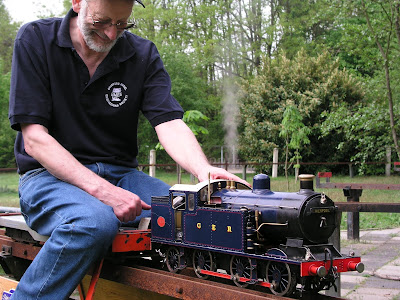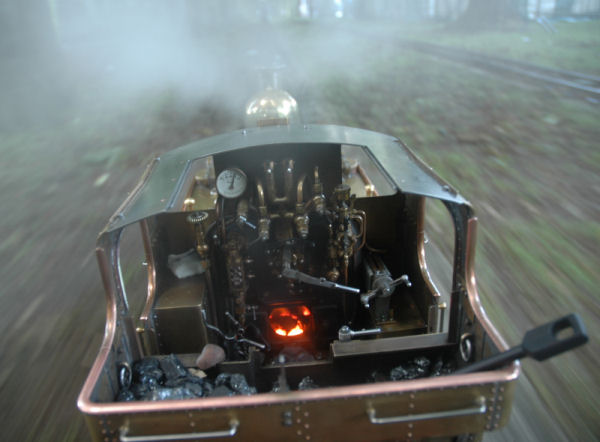Introduction to my steam locomotives:
"Gerry"
Firstly let me introduce myself. I’ve been involved with model engineering since 1979, when I started with a gauge 0 GER 0-6-0 ‘Buckjumper’.
This is a gauge 0 model of the Great Eastern Railway s56 'Buckjumper'. The model drawings of this engine came with the second hand home built lathe which my father had bought. Although the locomotive was completed, it was never a success, because my lack of craftsmanship, experience and lack of knowledge about live steam.
But it is still on a plinth in the living room and it got me hooked on building model live steam locomotives.
Firstly let me introduce myself. I’ve been involved with model engineering since 1979, when I started with a gauge 0 GER 0-6-0 ‘Buckjumper’.
This is a gauge 0 model of the Great Eastern Railway s56 'Buckjumper'. The model drawings of this engine came with the second hand home built lathe which my father had bought. Although the locomotive was completed, it was never a success, because my lack of craftsmanship, experience and lack of knowledge about live steam.
The gauge 0 model, my first attempt to build a model locomotive from metal.
Later on, back in 1995, I've even started a gauge 1 model of this GER s56 (LNER J69), but it is still unfinished.
My gauge 1 version of the s56
A general arrangement drawing by mr. James Holden's design ( R24 ) , from Model Railways of 1912
A scan of of the gauge 0 drawing
The loco in the early 1900's leaving Liverpool street station (London)
A picture of a gauge 0 model of the loco as found on the internet. Lovely model.
I've even made a concept drawing in Solidworks. Still playing with the idea of building a
5" gauge version of this locomotive.
Courtesy of FJ Roche
Courtesy of Model Railways
A sketch in 5" gauge. Would make a nice locomotive!
"Royal Scot"
A second engine - a gauge 1 London Midland & Scottish Railway 4-6-0 Royal Scot - was built, which was partly a success…. It was meths fired and it could run on its own steam, but not for long. But knowledge and experience increased and with a better lathe (a Myford ML7) I decided to build a bigger engine; the 'Mona' a 3½" locomotive.
The first Royal Scot, gauge 1 (1982)
Ten years later I've build a complete new Royal Scot in the same gauge; gas fired, it runs beautiful for a long period of time.
The second Royal Scot, gauge 1.
"Mona"
A 3.5” Great Eastern Railway 0-6-2 N7 class ‘Mona’ was built, and following the ‘words and music’ of ‘LBSC’. A booklet written by 'LBSC' was my guide to complete this loco. and it has become a very good passenger hauling engine, which I drive regularly.
I've based my 'Mona' on the Great Eastern Railway N7 class, as seen here in 1957 at Liverpool Street Station in London, together with the GER s56. The locos are in their usual immaculate condition, in Great Eastern Railway lined blue livery, but with the BR numbers. They were used as station pilot.


1996 at the annual Model Engineering Exhibition of Stoomgroep Zuid
Driving with the children in 1997 at our track in Breda
Malcolm driving the 'Mona'.

On our raised track in Breda
But also suitable for ground level driving, here at the SMMB in Tilburg
"Maisie"
 Of course some unfinished projects are still waiting on the shelf - a horizontal steam engine, - a gauge-0 0-4-0, - a 3.5” gauge 7 plank, open mineral wagon - and even a 3.5” gauge Large Atlantic 4-4-2 ‘Maisie’, also designed by 'LBSC' )
Of course some unfinished projects are still waiting on the shelf - a horizontal steam engine, - a gauge-0 0-4-0, - a 3.5” gauge 7 plank, open mineral wagon - and even a 3.5” gauge Large Atlantic 4-4-2 ‘Maisie’, also designed by 'LBSC' )
"Didcot"
The "Maisie" wasn't continued, because I thought an engine on a large scale was within the range of my capabilities.
I wanted it to be an engine in which I could incorporate more detail, closer to scale and looking like the prototype.
So, should it be a small 7.25” loco or something on 5”? And which locomotive would be a suitable prototype?
Over the years I’ve built up a small library, most books of which were picked up second-hand at local book shops. On sorting the books according to Railway Company, I found out that I had a lot of books on the Great Western Railway (England) . So I went through my collection of ‘Model Engineers’ and found that there was a 7.25” version of a GWR 14xx class locomotive (‘Dart’ by Martin Evans).
With an overall length of just over one metre, I thought this could fit the bill:
· I liked the appearance of the diminutive locomotive;
· I had several photos of the engine in my books;
· There are four prototypes preserved, which meant that I would be able to go and visit the real engine (as I did with the N7, The Royal Scot and the Large Atlantic);
· It looked simple enough;
· With only 6 wheels, it shouldn’t cost that much in terms of castings;
· It could be transported in the family car;
· On top of all this, I had the video tape of "The Titfield Thunderbolt", in which 1401 plays a major role.
So I took the decision in the summer of 1995 to start with the new project: a 7.25” ‘Dart’.
I studied the drawings, converted some of the dimensions to millimetres and discovered very quickly that most parts were bigger than they appeared to be in the magazine (although I have got used to working with the Imperial system over the years, I’m still not able to get an idea of size if the dimension is bigger than a few inches!).
To get a real feel of the size of the engine I thought it was best to start with a big part of the locomotive: the smoke box. (I usually make them from a piece of steel pipe, which I turn in the lathe). It turned out to be really BIG!. It could be made on my lathe, and even the hole for the chimney could be bored out on the milling machine, but I found that I was back where I started so many years ago. A lathe that was just not big enough to handle the parts that were to be made on it. A second drawback was that the material needed for building such an engine was hardly to be found in scrap boxes or otherwise easy (= cheap) to obtain.
So the project was abandoned very quickly, but what to do next?
( But now 10 years later (2006) I will try again to build a 7.25 gauge loco! )
A new Reeves catalogue was ordered, because somebody of our steam club, ‘Stoomgroep Zuid’, informed me that there was maybe a 5” gauge version of this engine. He proved to be right, and within a month I had drawings for the 5” version, wheel castings and horn blocks delivered on my doorstep.
What to do in between?? I started to browse the ME’s; reading about the IMLEC’s and other club meetings in Great Britain. Then I discovered a very interesting article about a 5” gauge shunting competition held at Gilling. Driving 5” trains at ground level……a complete train-set, just like 00, but then for real!
I knew this was what I would like to do; a small locomotive on 5” with only a few wagons would make a complete train.
The GWR 14xx is a small locomotive and in combination with, say, a brake van (20 ton Toad), a 7-plank mineral wagon, a 1 plank Match Truck and a Fruit van, it would make a nice set. To get warmed up, I ordered a set of drawings from an advertisement in the ME. It turned out to be from Doug Hewson, who kindly informed me about the GL5MRSociety and their magazine.
My membership started with issue 10 (winter 1995/1996) and I’ve been enjoying it ever since. Of course I’m not familiar with all the railway terms/expressions and abbreviations used in some of the articles (I have no railway background, as most of the members seem to have, but am willing to learn). So 5” gauge proved to be the right choice for me.
Ground level driving in Turnhout
In June 2017 Martin took the 'Didcot' with his wagons to the ground level track in Gilling, Yorkshire, England.
Complete with a set of Auto-coaches.
The 'Didcot' GWR 0-4-2, at speed at groundlevel track at Turnhout (Belgium) 2006
I finally cut the first metal for the new ‘train’, starting of course with the engine, in January 1996.
In 2004 the loco was nearly finished and in 2005 and 2006 did a lot of hard work on the track. The final paint job was done at the begin of 2007. This web-site will inform you about the construction stages of the locomotive.
In 2018 Toin bought a Winson kit and is now the proud owner of the second GWR14xx in our club
16mm Home built 'Dacre'
While still building the "Didcot", in 2002 I've build a 16mm narrow gauge loco. This was a project that I did with Dick Summerfield. He was thinking of buying a new 16mm loco, but we decided to build one from scratch. Dick had a booklet of Peter Jones 'Dacre'. A typical Welsh narrow gauge loco.
These gas-fired locos are quite simple to design and build and it was finished within three months.
He has a 32mm gauge track in his garden, were we had some lovely steam-up's with some club members.

A line up of my locos in Raamsdonkveer 2002, at our annual Model Engineering Exhibition.
"Württembergische T3"
A 7¼" gauge German locomotive. This is for model engineering the biggest gauge; 184mm. The scale of the loco is 1:8. Build between 2006 and 2017.
16mm Home built 'Dacre'
While still building the "Didcot", in 2002 I've build a 16mm narrow gauge loco. This was a project that I did with Dick Summerfield. He was thinking of buying a new 16mm loco, but we decided to build one from scratch. Dick had a booklet of Peter Jones 'Dacre'. A typical Welsh narrow gauge loco.
These gas-fired locos are quite simple to design and build and it was finished within three months.
He has a 32mm gauge track in his garden, were we had some lovely steam-up's with some club members.

A line up of my locos in Raamsdonkveer 2002, at our annual Model Engineering Exhibition.
"Württembergische T3"
A 7¼" gauge German locomotive. This is for model engineering the biggest gauge; 184mm. The scale of the loco is 1:8. Build between 2006 and 2017.
GER Y14
The latest project is a Great Eastern Railway 0-6-0 Y14 class steam locomotive, built on 5" gauge.
Started already in 2020 with buying materials and a first general design in Solidworks, this project really took of in september 2022.
Current build status as of August 2025
Click below for direct link to start of construction series of:






























































































